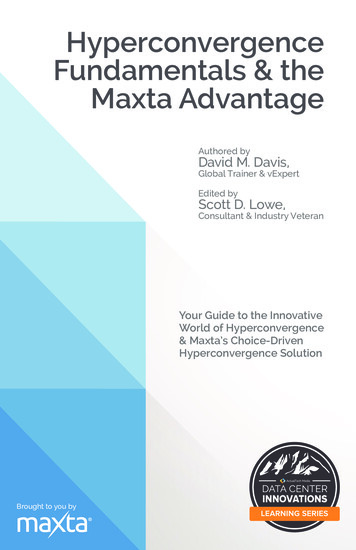
Transcription
Welcome to the Fundamentals of Business Analysis course!Fundamentals of Business Analysis is a core course in the Business AnalystCertificate Program. This program focuses on the set of tasks and techniques abusiness analyst uses to work as a liaison among stakeholders in order tounderstand the structure, policies, and operations of an organization, and torecommend solutions that enable the organization to achieve its goals.Today, business analysis encompasses a set of well-defined skills andknowledge that combine traditional business topics with technical topics. Thisis because the solution to business problems often involves theimplementation of some sort of technology-centered solution.
Fundamentals of Business Analysis provides an overviewof the contents of the International Institute of BusinessAnalysis (IIBA ) Business Analysis Body ofKnowledge (BABOK ). The BABOK Guide describesbusiness analysis areas of knowledge, their associatedactivities and tasks, and the skills necessary to beeffective in their execution. The current version of theBABOK is version 2.The goal of the IIBA in having a well-defined body ofknowledge is to set a globally recognized standard for theindustry that delineates the tasks business analystsshould be capable of carrying out. The IIBA provides an internationally recognized certification, the CertifiedBusiness Analyst Professional (CBAP ). Candidates must take an exam that tests them on their knowledge ofbusiness analysis skills in general and the BABOK in particular.
Fundamentals of Business Analysis is specificallyOf course, not all business analysis necessarily leads todesigned to give people new to the business analysttechnology implementations. In some situations, therole or those who supervise business analysts a basicsolution might be a simple redesign of an existingunderstanding of the functions and business impact ofprocess. However, the vast majority of businessthis role. The course provides a special focus onprojects that use business analysts today have a largebusiness analysis functions as they relate to theInformation Technology (IT) component as part of thedevelopment of technology solutions that meet specificproject, hence our course will tend to lean in thatbusiness needs.direction.
This lesson concentrates on some of the more prominent roles,responsibilities, and competencies for the business analystposition.Upon completing this lesson, you should be able to:Explain why businesses need business analystsDescribe the main job duties of a typical business analystDescribe the contents and purpose of the IIBA BusinessAnalysis Body of Knowledge Explain the relationship between business processes andtechnology-based solutions that implement theseprocesses
Why Do Businesses Need a Business Analyst Position?In the days before the Industrial Revolution, most products wereproduced by craft workers who accomplished the whole process ofconstructing a product, not just the manufacturing, but the marketing,sales, design, and service as well.In 1776, with Adam Smith's Wealth of Nations, the IndustrialRevolution began, and with it, the need for specialization. In thetime of the craftsperson, when the entire process could be run by oneperson, the output from that process was very limited. With the rise ofthe Industrial Revolution and the use of specialists, however, a processcould yield incredibly more output.For example, where a craftsperson could yield less than 20 pins perday, a team of 10 people, each specializing in a certain aspect of theprocess, could work together to produce 48,000 pins per day. Pleaseclick on the links below to learn more about the Industrial Revolution:The Origins of the Industrial Revolution in England
SpecializationSpecialization, while producing great advancements in terms of output, brought with it a set ofunique problems.As companies benefited by increasing output andreducing the price of their product, they needed evenmore specialists to run the entire organization.Specialists were not found just in manufacturing but inother areas such as finance, accounting, legal,personnel, marketing, and sales. This specialization ledto functional organizations within enterprises.Why? One reason is that it is easier to manage peopleand their activities if they are grouped into specializedfields or functions. Nonetheless, this functionalorganization led to three distinct types of problems, asshown in the table at right.
Process OrientationThus began a need for looking at an entire process in a way that could lead to improvement in that process. Thisbecame known as business analysis, business process reengineering, or continuous processimprovement.This concept really took off in 1993 when M. Hammer and J. Champy wrote Reengineering the Corporation.From that point on businesses used a process orientation to business improvement. Process orientation isinvolved in looking at the processes that make up the organization, as opposed to the departments thatmake up an organization, to determine which processes contribute to or detract from an organization'scompetitive advantage.This approach can help businesses deliver more value to the customer. They can determine which processes addto or detract from the value the organization creates for its customers and then they can focus their attention onthose processes that add the most value.Read an excerpt of Reengineering The Corporation: A Manifesto for Business Revolution.
Business InformationThough organizations have been using computers (albeit large ones) since the 1950s to store business data andprocess transactions, the introduction of the desktop computer in the 1980s and the Internet in the 1990scombined with the user-friendly ways in which people can interact with computers through intuitivegraphical interfaces (i.e. "windows" and "mice") led to an explosion of information technology in nearly allbusiness functions that involve data storage and communication.In addition, computers allow us to perform complexHere is where business analysts enter the scene.mathematical operations that allow us toTheir job is to become knowledgeable aboutstreamline many kinds of business processes andbusiness needs (and challenges) in terms of businessincrease the efficiency of such diverse operations asprocesses and functions, and then work on projectrouting delivery trucks, scheduling events, andteams with technical professionals to develop solutionsmaximizing the usage of physical storage space. Theseto improve those processes and functions. Again, ITfunctions can be integrated seamlessly into ansolutions are perhaps the most frequent end productorganization's overall business strategy to achieveof these kinds of projects, but a good business analystgreater productivity at a lower cost.knows when other solutions may be more appropriate.In fact, an emerging business challenge may not already have a well-defined process in place, so the solutionmight be to develop a new process altogether.
Business Analyst TitlesBusiness analysts are involved in activities like:proposing a new business process to solve abusiness problem;determining which business processes can bestreamlined with software applications;eliciting specific user needs and proposingappropriate technical solutions; orworking with technical professionals to ensurethat the solutions they are building meet theneeds of end users.While the correct term to use for this position is business analyst, other terms have been used as well. For thisclass we emphasize that the correct term is business analyst, and the work they do is business analysis.However, in the box at right you will see some other job titles that have been applied to people who carry outbusiness analyst activities.
The Business Analyst and the Project ManagerWhile projects exist because of stakeholders, projects are managed by Project Managers— not business analysts.Business analysts are often the liaison between the end users and recipients of the project deliverables, and theproject manager.The Project Manager (PM) is a special type of stakeholder that has been assigned the overall responsibility forthe project. The PM is responsible for managing the project activities and for ensuring that the project'sobjectives are met while balancing the project constraints, including scope, budget, schedule, resources, quality,risk, and others.In contrast, the Business Analyst (BA) is responsible for eliciting the actual needs of stakeholders and works tofacilitate communication among organizational units, serving as a "translator" in aligning the needs of businessunits with the capabilities delivered by information technology.In a project, the business analysis activities are integrated with and are a component of the overall project plan.The BA coordinates duties with the PM in planning business analysis activities. The Project Manager, however, isresponsible for ensuring that those plans are integrated with the work performed by other project personnel. Inaddition, the scope of business analysis work within a project is managed as part of the overall project scope,and changes to that scope of work (for example, as new stakeholders are identified or business requirementschange) may require approval of a project scope change. The PM also plays a key role in identifying resources toperform tasks, scheduling the activities, and developing cost estimates.
1.Why did specialization, which arose largely as theresult of the industrial revolution, give rise to a needfor business analysts?a.Business activities became more complex, beingcomposed of many smaller steps, which led toinefficiencies that could be identified and reduced oreliminated through careful analysis.b.Because specialization occurred only after companiesbegan installing computers to streamline processes,business analysts were needed to write software programsto operate large industrial machinery.c.The industrial revolution brought increased competitionamong companies along with a risk of financial instability.Consequently, business analysis became necessary to helpcompanies decide where to invest their profits for greaterreturns.
2.Do business analysts work on projects that don'tinvolve information technology?a.Never - computers are what make process re-engineeringpossible.b.Always - information technology is useful for storing andmanipulating information, not for improvingfundamental business processes.c.Sometimes - business analysts often work on projects thatinvolve IT solutions, but sometimes simply changing abusiness process is sufficient to achieve processimprovement.
The IIBA and the BABOK The International Institute of Business Analysis (IIBA)held its inaugural meeting in October 2003, in Toronto,Canada. As of July 2009, there are 13 local chapters inCanada, 63 in the United States, and 30 in countriesoutside North America.The IIBA is poised to become the international authorityon business analysis. It has developed a certificationexam that aims to raise the business analysisprofessional's stature substantially among the ranks ofprofessional workers. The exam is based on the BusinessAnalysis Body of Knowledge (BABOK ), which describes the role and responsibilities of a typical businessanalyst. People who pass the exam become Certified Business Analysis Professionals (CBAP ).Learn more about the IIBA Learn more about IIBA Certification
The IIBA and the BABOK The contents of the BABOK are based on extensive interviews withpracticing business analysts along with observational studies ofbusiness analysts at work. It is divided into six major Knowledge Areas:1. Enterprise Analysis2. Business Analysis Planning and Monitoring3. Elicitation4. Requirements Management and Communication5. Requirements Analysis6. Solution Assessment and ValidationIn addition, the BABOK outlines the behaviors, knowledge, andpersonal characteristics that support the effective performance ofbusiness analysis in the Underlying Competencies section.Note: The BABOK includes a glossary which provides standardized definitions of commonly used businessanalysis terms (such as the different types of requirements, diagrams, tools and job role definitions).This course will introduce each of these Knowledge Areas and prepare you for further, more detailed study ofthese topics in subsequent Business Analyst Certificate Program courses.
The BABOK is divided into six major Knowledge Areas in which business analysis tasks and the techniques toperform these tasks are defined. These Knowledge Areas are supported by Underlying Competencies (i.e., "softskills").Note: these Knowledge Areas are not intended to represent phases in a project.Diagram from Business Analysis Body of Knowledge (BABOK guide), Version 2.0, 2009, InternationalInstitute of Business Analysis, Toronto, Ontario, Canada, page 7.
Overview of the BABOK Knowledge AreasNow let's take a closer look at each of the Knowledge Areas describedin the BABOK . We won't go into a lot of detail here, that's for theremaining lessons in the course! The Knowledge Areas include:1. Enterprise Analysis2. Business Analysis Planning and Monitoring3. Elicitation4. Requirements Management and Communication5. Requirements Analysis6. Solution Assessment and ValidationBABOK Cover, Business Analysis Body of Knowledge (BABOK guide), Version 2.0, 2009, International Institute of Business Analysis,Toronto, Ontario, Canada.
Overview of the BABOK Knowledge AreasEnterprise AnalysisOrganizations undertake projects for a variety of reasons ranging from solving a particular process problem topursuing a new business opportunity. In the most general sense, a project consists of a set of steps or tasks thatmust be completed to achieve some desired end result. Obviously, this end result must support or contribute tothe organization's mission, vision, and goals. The business analyst comes on the scene even before a project isformally chartered. He must understand the organization's mission, vision, and goals thoroughly, and often mustcontribute to organizational strategic thinking that not only affects how products and services are developed butwhat products and services are (should be) developed.A business analyst begins the Enterprise Analysis process by gaining an understanding of the organizationalenvironment in which a project is to be carried out and how that project can contribute to the organization'smission, vision, and goals. This may require a systematic, documented approach that often focuses on overallorganization architecture and high-level business objectives. Good analyses allow management to prioritizeamong various projects and develop effective procedures for eliciting requirements.
Example of Enterprise AnalysisAs an example of enterprise analysis, consider an online shoppingcompany that is plagued by high fuel expenses, late deliveries,incomplete or incorrect orders, and a declining customer base. The firststep in performing enterprise analysis is to identify the key businessobjectives of the company and then identify the obstacles it faces inachieving those objectives. Next, analysts must begin identifyingpotential solutions to those obstacles and determine which solution islikely to be the most effective.In our example, analysts discovered that the company's deliverydepartment scheduled deliveries manually, which led to delivery trucksleaving the central warehouse only partially loaded and often having tocrisscross the city to make deliveries. In addition, stock clerks were notdocumenting the contents of the boxes they filled so some boxes hadmissing items while others had duplicate items.Thus, the objectives of the "delivery improvement project" were to:1. Reduce fuel expenses2. Decrease the time needed to deliver boxes of products3. Increase the accuracy of the orders4. Retain and eventually expand the customer baseActually, item number 4 is probably the overarching goal; in order to achieve number 4 one must first achieveitems 1, 2, and 3.
Example of Enterprise AnalysisEventually, the analysts concluded thata computer-based scheduling approach could route the delivery trucks more efficiently and help reduceboth fuel consumption and delivery times, anda database-driven inventory control system could increase the accuracy of the shipments.These requirements uncovered by the business analyst are high-level requirements.With further research and analysis, a business case was defined and presented to management showing howmuch money would be saved and how much new business might be generated by implementing the project.Note that we haven't yet gone into any of the details of exactly what the new systems are going to look like - sofar we've been focused on "big picture" outcomes.
Other Knowledge AreasBusiness Analysis Planning and MonitoringAfter a business analyst has a reasonable idea of what hisproject is trying to achieve, he needs to work onplanning how the business analysis activities are goingto be performed. As part of this plan, he'll also determinehow to asses the progress of the business analysis effortonce it is ongoing - the monitoring component of theplan.A list of typical business analysis activities forPlanning and Monitoring:Defining and determining the business analysis processes that will be usedIdentifying the stakeholders and defining their roles and responsibilities in the business analysis effortPlanning how requirements will be approached, traced, and prioritizedDetermining the deliverables that the business analyst will produceDeveloping estimates for business analysis tasks, as well as determining the metrics that will be used formonitoring business analyst work
The Elicitation Knowledge AreaPer the BABOK , elicitation "is an activity within requirementsdevelopment that identifies sources for requirements and then useselicitation techniques (e.g., interviews, prototypes, facilitatedworkshops, documentation studies) to gather requirements from thosesources."Projects can fail if the end product either doesn't function correctly ordoesn't do what the users want it to do. In the latter situation, theproblem can usually be traced back to poor requirements gathering,which is why we want to emphasize how important it is to plan therequirements elicitation process carefully. It is imperative to findout as precisely as possible what the users (and other stakeholders)want the solution to do.Back to our online shopping company.Let's focus on the system for scheduling and routing deliveries. The users of this system include truck drivers,loading dock dispatchers, inventory managers, and others. The business analyst would start by going to thesestakeholders to find out how they perform their work and what specific functions they need the system toperform. Stakeholders with roles in processes are also known as actors. Look up a description for actors on page204 of the BABOK. In addition, she would talk to supervisors and other managers who want to monitor the delivery process to seewhat kinds of information they would find useful.In planning these visits, the analyst needs to schedule meetings, identify the best elicitation techniques, andensure that her activities are well-coordinated with the activities of others working on her project team.For other stakeholders and their role in a project, click here.For a list of elicitation techniques, click here.
Overview of the BABOK Knowledge AreasRequirements Management and CommunicationWe already alluded to the notion that documentedA business analyst must be able to adapt the messagerequirements must be communicated to stakeholdersto the audience. That is, she should useand others in the project. The Requirementscommunications methods that are appropriate for theManagement and Communication knowledge areaintended audience. For example, an organization'scovers the activities necessar
on business analysis. It has developed a certification exam that aims to raise the business analysis professional's stature substantially among the ranks of professional workers. The exam is based on the Business Analysis Body of Knowledge (BABOK ), which describes the role and respons










